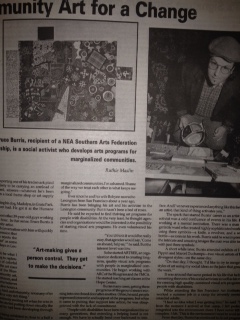February 1995
COMMUNITY ART FOR A CHANGE
Bruce Burris, recipient of a NEA Southern Arts Federation Fellowship, is a social activist who develops art programs for marginalized communities
by Ruthie Maslin
He can usually be seen sporting one of his trademark plaid shirts and a cap. He’s likely to be carrying an armload of stuff — paper, matte board, scissors — whatever he’s been able to get donated from a local frame shop or art supply store.
Or he might be walking his dog, Madolyn, in Gratz Park. She’s the first dog he’s ever had. He got her at the Humane Society.



He looks a lot like other 39-year-old guys working 25 hours a week for $6 an hour. In that sense, Bruce Burris is a pretty typical community artist.
But a few minutes of conversation with him will quickly disabuse you of any impression that he’s typical, and Burris rejects the idea of “community artist” as some sort of specific role he plays in Lexington.
“Art just happens to be what I do,” he explains, pausing to replenish the glue and scraps of colorful paper on the tables in the art class he’s leading for ARC of the Bluegrass. “It isn’t just community art, really. It’s community activism, and I happen to be an artist who believes when people do art for a few hours a day, it’s a very rich thing. And, unfortunately, not many of us get the opportunity to do a very rich thing.”
Burris first began seriously making art when he was in his 20s. That was when he started putting down visually the social consciousness that he had been developing through his teens and early 20s.
Today, his work is being exhibited in close to half a dozen galleries across the country, from Atlanta and Washington DC to San Francisco. This year, he received a prestigious National Endowment for the Arts/Southern Arts Federation Fellowship.
In addition to working on his own painting, Burris is heavily involved in community work these days. He’s artist-in-residence in a Cincinnati housing project and does visual arts programming with several Lexington organizations, including ARC of the Bluegrass and their College for Living Program, the Writer’s Voice of the YMCA of Central Kentucky, and the Christian Health Center.
“Why I do this is for no courageous or noble reason,” he said. “It’s guilt. When I see how the larger community treats marginalized communities, I’m ashamed. Shame of the way we treat each other is what keeps me going.”
Ever since he and his wife Robyn moved to Lexington from San Francisco about a year ago, Burris has been bringing his art and his activism to the Lexington community. But it hasn’t been a bed of roses.
He said he expected to find thriving art programs for people with disabilities. At the very least, he thought agencies and organizations would be interested in the possibility of starting visual arts programs. He even volunteered his time.
“You’d think it would be really easy, that agencies would say, ‘Come on aboard, help us,'” he said. But the interest level was low.
So he started ARTREE, an organization dedicated to creating longterm quality visual arts programs with people in marginalized communities. He began working with ARC of the Bluegrass and the YMCA. He started teaching art classes at the Hope Center.
But in many cases, getting these programs off the ground meant running into one closed door after another. Often, he said, people expressed interest in and support of the programs, but when it came to putting that support into action, he ws disappointed with the lack of commitment.
“People with disabilities have been marginalized for so many generations, that extending a helping hand is not enough. We have to actually bend over backward to integrate them into the larger community.”
Currently, his art deals with many of the issues that contribute to or are a part of exclusionary politics — homophobia, racism, religious zealotry. Burris said recently, he has been struck by the intensity of the hate messages on signs of marchers for various issues and on floats in parades. He said the signs are such an odd mixture of religion and hate, all carefully put together, yet filled with misspelled words and illogical reasoning.
“You are confronted specifically with their intentions. Your jaw drops. It has an incredibly angry and mean effect.”
His move from the West Coast to the South has also impacted his art in a major way, primarily through the blatant racism he sees around him.
“The allusions to racism in my work were always veiled. But the racism here is not veiled. It is direct.”
“I don’t think this area is any more racist than northern California. It’s just that here, the gloves are off. It’s in your face. And I’ve never experienced anything like this before. As an artist, that kind of thing activates you.”
The spark that started Burris’s career as an artist and an activist was an odd confluence of events in his life. He was working at a mental institution. There was a man on the geriatric ward who created highly sophisticated works of art using three symbols — a knife, a revolver, and a whiskey bottle — as icons in his work. Burris said he was impressed by the intricate and amazing images the man was able to create with just three symbols.
A short while later, Burris attended exhibits of Horace Pippin and Marcel Duchamps — two visual artists of highly divergent styles — on the same day.
“On that day, I thought, ‘I’d like to try to merge these styles of art using my social ideas as the juice that generates the work.”
It was around that same period in his life that he began cementing the roots of his social activism as well as his vision for creating high quality, sustained visual arts programs for people with disabilities.
While attending the San Francisco Art Institute, he worked a summer job in a camp for severely mentally-retarded adults.
“I had no idea what I was getting into,” he said. “But from the moment I arrived at that camp, I felt perfectly integrated into the environment there. I have never felt so complete. I felt, ‘this is the environment I need to work in.'”
From that day, Burris has continued to do art programs in marginalized communities, from nursing homes and homeless shelters to housing projects, because, he believes, art is a very powerful thing for people who are disenfranchised from the larger community.
“In all the environments I work in, from house communities to apartment programs for disabled adults, the one thing that they hall have in common is that these people have very little control over their lives. Art-making gives a person that little control over their lives. Art-making gives a person that control. They get to make the decisions. They get to say what they have to say in a way they can. For that moment, they have control.”
“The philosophy behind art is nothing high-faluting or spiritually transcendent,” Burris says, stopping to look at the cut-paper Christmas tree one of his students has just completed. We’re trying to piece our lives together and trying to piece together the communities all around us. Art is just a vehicle to express how we all fit.”
“I don’t really know why art is important. I just know that is important.”








